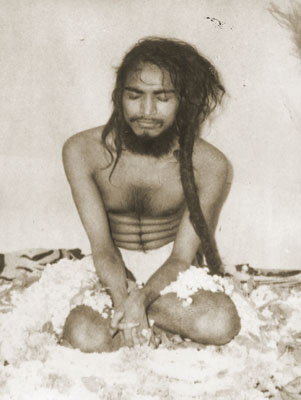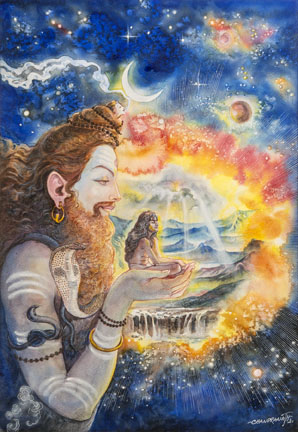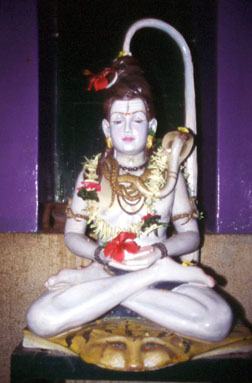HIS LIFE HOME PAGE | PREVIOUS PAGE | NEXT PAGE
Shiva Shankara Bhagavan
“The outside guru is a yogi. The inner guru is God, Shankara Bhagavan.”
Shivabalayogi's guru is Shiva. The tall, handsome ascetic who initiated Sathyaraju into tapas and appeared periodically over twelve years to aid and instruct Shivabalayogi during his tapas — and since — is a form of Shiva, God the Destroyer.
In the West we are somewhat frightened by the traditional Indian concept of Shiva. He is often depicted with ash smeared over his body, human skulls around his neck, and wearing poisonous cobras around his neck and arms. His other name "Hara" means “Destroyer”, which does little to foster the warm feelings we might get from, say, “God the Father.” But Shiva's many names include Shambhu (“Abode of Peace”) and Shankara (“Maker of Peace”).
Swamiji assured people that Shiva is love, and he will never stop loving us, no matter what we do. Swamiji describes Shiva as very benevolent, that he will not refuse a boon to anyone. Hence another of Shiva's names, Bhaktavashankara, which refers to Shiva being eager to grant boons to his devotees.
Swamiji often said that Shiva is the same as God the Holy Spirit in the Christian tradition. That would help explain the destructive aspect of Shiva because the Holy Spirit is associated with fire, and fire destroys and purifies.
Brahma is considered God as Creator, Vishnu is God as Sustainer, and Shiva is God as Destroyer, Creation is an illusion and Shiva is its Destroyer. Shiva is God as a Yogi, which is why ascetics worship God in the form of Shiva.
Shiva, as Swamiji once said, is also the inner God, the inner Guru, our true Self. This adds a deeper meaning to the symbolism of the Shiva linga. It represents the soul, the thumb-sized form that mystics “see” inside the heart cave.
“Whenever Swamiji wishes to see his guru, he appears in front of Swamiji. Swami does service for the people only with the direction of his guru. Swamiji follows the directions very exactly. He goes somewhere only at the direction of his guru. His guru made him do tapas for doing service to the public, so he follows whatever directions his guru gives.”
Shivabalayogi quotes on Shiva, on
Shiva's overly generous nature, the
Inner Guru,
Shiva's universality, and
Shiva Lingas.

Shivabalayogi in 1957, after having completed and mastered tapas to the west.
Enlightenment Is the Beginning of Tapas
Shivabalayogi used the English word "enlightenment" for samadhi and explained that attaining enlightenment is only the first step in the process of tapas. A yogi who has successfully completed tapas is more than enlightened, Shivabalayogi would say. Such a yogi is Self realized.
Tapas is completed when God manifests and declares it successful. Until then, the person doing tapas must continue meditating in samadhi at least twelve hours every day.
The Indian scriptures, Yoga Shastras, state the general rule that a yogi should perform tapas for twelve years, an austerity called yuga tapas, and that a yogi should master tapas in all four cardinal directions, an austerity called dikh tapas.
Yuga (Twelve-Year) Tapas
Tapas could be completed in five years (Lord Buddha), or twelve years (Lord Jesus), or thousands of years (the ancient sages Valmiki and Vishwamitra are examples). Uninterrupted tapas for twelve years is known as yuga tapas, the number twelve being a particularly auspicious symbol of completion.
Dikh Tapas, Mastery of Each Direction
Tapas is done in the same direction until siddhi of that direction is attained. Siddhi means accomplishment or perfection and also implies spiritual power. Dikh siddhi could be translated as victory of a direction.
Each direction has its own qualities, difficulties and rewards, understood only by one who has mastered it and attained the powers of that direction. East is said to be the easiest direction for spiritual practice. North is the next most conducive to meditation, and the person facing this direction experiences bliss during samadhi. South is a more neutral direction. Tapas to the west is fraught with obstacles. One must overcome seemingly insurmountable mental tests and physical afflictions.
One who attains dikh siddhi of all four directions and completes the yuga tapas is known as a rishi or sage. Such a person is a true yogi, a jnani yogi who has attained Ultimate Knowledge. Only such a person can claim to be fully God realized.
Tapas to the East
It happened, perhaps by the guru’s express instruction or by subtle suggestion, that Swamiji commenced tapas facing east. He went into deep nirvikalpa samadhi around the end of September of 1953. Among the different levels of samadhi, nirvikalpa samadhi is when all sense of identity or ego is lost. Only the awareness of bliss remains. This samadhi became continuous and the yogi dispensed with even the short break he used to take each midnight for his bath and milk. Balayogi remained in continuous samadhi for an entire month until October 28, 1953, when Lord Shiva manifested inside the Dhyana Mandir and tapped the young yogi on the leg to bring him to ordinary consciousness. He had completed and mastered tapas to the east.
Journey to the World of the Sun

During tapas to the East, Shivabalayogi attained siddhi (mastery) of Surya, the Sun. His Divine Guru took the young yogi on a journey to see inside the world of the Sun.
Soorya Sandharshana. Painting by Chandranath Acharya.
Tapas to the North
From time to time, the Divine Guru manifested before Swamiji to give instructions and support. He would appear in the same form of a yogi as when he first emerged from the Shivalinga to initiate Sathyaraju into tapas. Having mastered tapas to the east, the Divine Guru instructed the young yogi to turn to the north.
Tapas facing north proceeded uneventfully. Swamiji enjoyed good health and experienced great bliss during samadhi. Around July 15, 1955, he once again went into deep nirvikalpa samadhi which continued without break for fifteen days. On the night of August 1, 1955, Swamiji once again had God realization of Shankara Bhagavan, Lord Shiva, and thus attained siddhi of the northern direction. As before, when the young yogi had mastered the eastern direction, Shankara Bhagavan conversed with him for sometime. Before he left Lord Shiva asked the yogi whether he wanted anything. Characteristically, Swamiji replied that he desired nothing.
Tapas to the West
At midnight on August 7, 1955, the Divine Guru once again appeared. He told his disciple that the next phase of his tapas would be facing west. He warned Swamiji that he would have to overcome many difficulties and obstacles in this phase of tapas. The challenges would be severe at times, but he should not lose heart and must on no account give up. Then he reassured his disciple that whenever he needed help the guru would come to his assistance. Finally he gave the appropriate mantra for tapas of the western direction and disappeared.
The guru’s warning about dangers confirmed warnings in the scriptures about the difficulties that await the yogi who undertakes tapas facing west. Many well known tapasvins (one who undertakes tapas) have come to grief doing tapas towards the west.
Swamiji almost immediately suffered a severe stomach ache and his skin was afflicted with a burning sensation. He was unable to take even the one glass of milk that had sustained the life of his body. Devotees fed him Horlick's, a commercially made malt beverage. At one time, blood oozed like sweat from his hair follicles over a two day period. On another occasion, hundreds of painful boils erupted all over his body. He could ignore these when in samadhi because he was unconscious of his body and its aches and pains. However, he was acutely aware of the pain and suffered greatly when he emerged from samadhi each midnight.
His troubles were often aggravated by news he periodically received about the death of some friend or relative, or about the various difficulties others were having.
After one midnight, when Balayogi was getting water for himself, an apsara (a celestial nymph) appeared and tried to seduce him. The young yogi ignored her and resumed his meditation.
On another night, an old but supernaturally strong man appeared and tried to make the young yogi break his vow of silence (mouna) and physically drag him back to his family’s home in the village. Swamiji was weak from the intensity of his tapas and the various illnesses he had suffered. He barely had enough strength to attend to his daily bath and other needs. He could hardly hope to resist this amazingly powerful old man. In desperation, Swamiji grabbed the short staff that he used to support himself. With all the strength he could muster, he struck the old man’s arm to make him release his vice-like grip. The impact broke the staff in two and Swamiji momentarily lost consciousness. When he recovered a minute or so later, the old man had disappeared. Thinking no more of this incident, Swamiji completed his bath and returned to the Dhyana Mandir. To his surprise, he found the other half of his broken staff lying on the tiger skin asana. He realized that the old man had been sent to test his resolve and strength of purpose.
A yogi must never retreat. It is an inviolable rule among yogis that when faced with an obstacle, they may remove it, they may avoid it by going around, but they must never turn back, particularly if such action smacks of fear. One night on his way to bathe, Swamiji found a very large, amber-colored cobra barring his path. He calmly looked for some way to go around, but there was none. So he stepped on the coiled body of the cobra and walked over it. That was asking for trouble and with an angry hiss, the cobra bit him on the left thigh. He continued undeterred to have his bath. On his return he found the cobra still coiled up across the doorway of the Dhyana Mandir. Once again he had no alternative but to step over the cobra to re-enter his room. Once again the cobra viciously bit him, this time on the big toe of his right foot. Unperturbed by what had happened, Swamiji closed the door of his meditation room and prepared to resume his samadhi. But the poison from the two bites had taken effect and before he could take his position to meditate, he fell unconscious onto the wooden platform.
Swamiji had attained immunity from the bites of cobras and other poisonous animals through his mastery of the aum namah shivaya mantra, but this amber colored naag was no ordinary cobra. It was the same cobra that garlands the neck of Shiva. It had come to test the young yogi. Swamiji remained unconscious on the wooden platform for four days. Finally, at six in the morning of the fourth day after the great cobra had bitten him, the Divine Guru appeared and aroused Swamiji from his unconscious state. He got up and resumed his usual meditation seat, but he was extremely weak from the ordeal he had just undergone.
After nine months of tapas facing west, Swamiji’s body had been racked with illnesses and afflictions of all kinds and was on the verge of collapse. The skin had cracked open in several places, exposing deep fissures and wounds which bled regularly. But the pains of his body did not disturb the serenity of the yogi’s mind. He had long before realized through direct personal experience that he was not the body but the indwelling atman (the transcendental Self) which is not troubled by afflictions of the body. Firm in this realization, he continued his tapas completely indifferent to whether his body survived or perished.
The worst was over and the completion of tapas toward the west was near. He sat calm and unconcerned on his asana and, as directed by his Divine Guru, passed into deep nirvikalpa samadhi. He remained in unbroken samadhi for a month. Then around midnight of the 25th of June, 1956, he felt a light tap that slowly brought him back to ordinary consciousness. He slowly became aware of his surroundings but all he could see was a dazzling light. He could not quite decipher whether the light came from within himself or from without. He was in indescribable peace and bliss and might have passed into samadhi again when he felt another light tap. This time he opened his eyes and standing before him were the gods Shiva and Parvati in the forms of Girija and Natesan. His God realization signified his successful mastery of tapas to the west.
Tapas to the South
Shivabalayogi was instructed to do tapas towards the south, which he completed in a little over ten months. In May of 1957, he again had sakshatkara (God realization) of Shankara Bhagavan and with that attained mastery of the southern direction and dikh siddhi of all four directions. He was twenty-two years old at the time and had been meditating twenty-three hours a day for eight years.
According to the Yoga Shastras, it ordinarily requires a minimum of four years to attain siddhi of any direction, which means it would take a minimum of sixteen years to attain siddhi of all four directions. Shivabalayogi attained dikh siddhi of all four directions in a little less than eight years.




